INFINITI Q60 2020 Service Manual
Manufacturer: INFINITI, Model Year: 2020, Model line: Q60, Model: INFINITI Q60 2020Pages: 476, PDF Size: 2.05 MB
Page 41 of 476
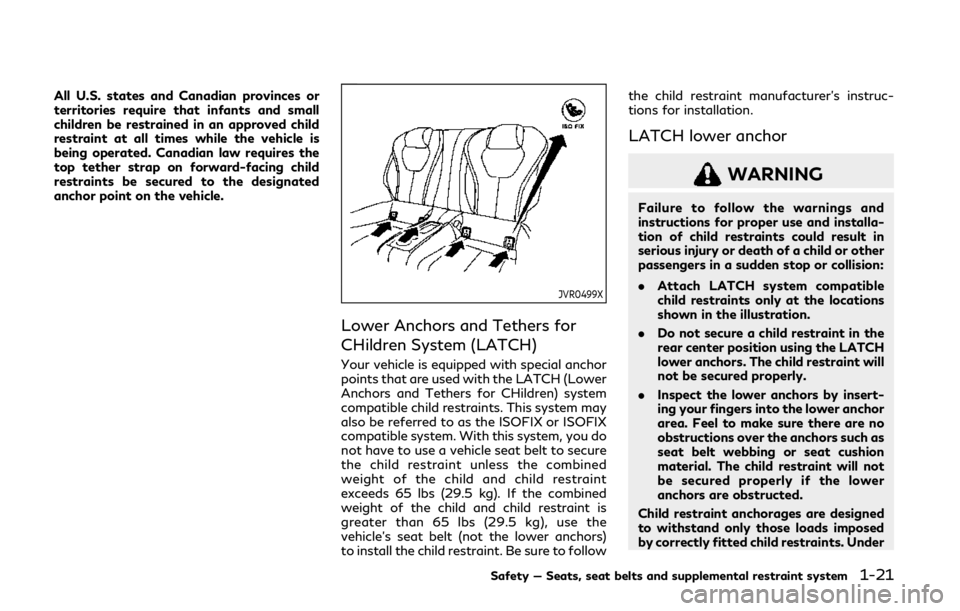
All U.S. states and Canadian provinces or
territories require that infants and small
children be restrained in an approved child
restraint at all times while the vehicle is
being operated. Canadian law requires the
top tether strap on forward-facing child
restraints be secured to the designated
anchor point on the vehicle.
JVR0499X
Lower Anchors and Tethers for
CHildren System (LATCH)
Your vehicle is equipped with special anchor
points that are used with the LATCH (Lower
Anchors and Tethers for CHildren) system
compatible child restraints. This system may
also be referred to as the ISOFIX or ISOFIX
compatible system. With this system, you do
not have to use a vehicle seat belt to secure
the child restraint unless the combined
weight of the child and child restraint
exceeds 65 lbs (29.5 kg). If the combined
weight of the child and child restraint is
greater than 65 lbs (29.5 kg), use the
vehicle’s seat belt (not the lower anchors)
to install the child restraint. Be sure to followthe child restraint manufacturer’s instruc-
tions for installation.
LATCH lower anchor
WARNING
Failure to follow the warnings and
instructions for proper use and installa-
tion of child restraints could result in
serious injury or death of a child or other
passengers in a sudden stop or collision:
.
Attach LATCH system compatible
child restraints only at the locations
shown in the illustration.
. Do not secure a child restraint in the
rear center position using the LATCH
lower anchors. The child restraint will
not be secured properly.
. Inspect the lower anchors by insert-
ing your fingers into the lower anchor
area. Feel to make sure there are no
obstructions over the anchors such as
seat belt webbing or seat cushion
material. The child restraint will not
be secured properly if the lower
anchors are obstructed.
Child restraint anchorages are designed
to withstand only those loads imposed
by correctly fitted child restraints. Under
Safety — Seats, seat belts and supplemental restraint system1-21
Page 42 of 476
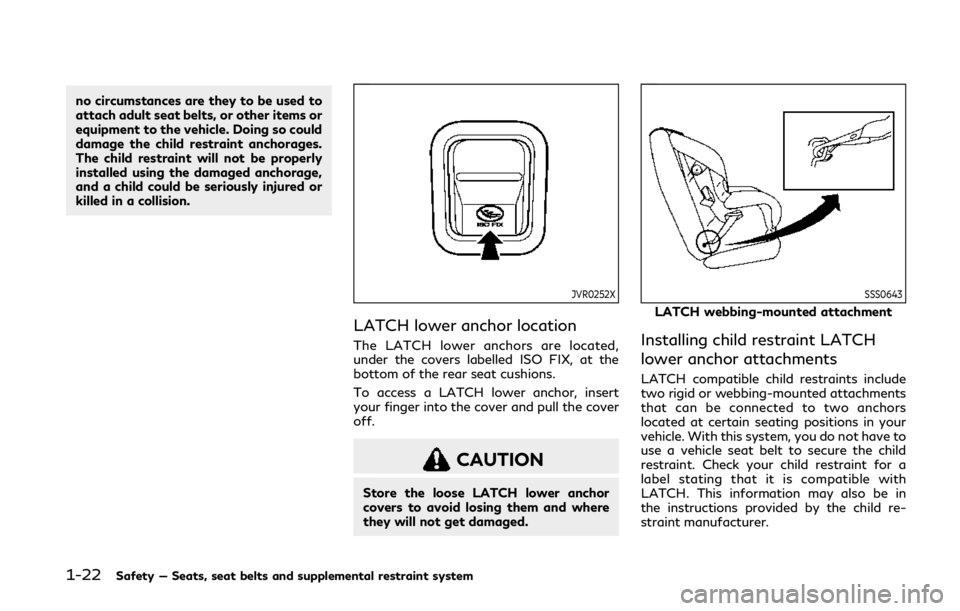
1-22Safety — Seats, seat belts and supplemental restraint system
no circumstances are they to be used to
attach adult seat belts, or other items or
equipment to the vehicle. Doing so could
damage the child restraint anchorages.
The child restraint will not be properly
installed using the damaged anchorage,
and a child could be seriously injured or
killed in a collision.
JVR0252X
LATCH lower anchor location
The LATCH lower anchors are located,
under the covers labelled ISO FIX, at the
bottom of the rear seat cushions.
To access a LATCH lower anchor, insert
your finger into the cover and pull the cover
off.
CAUTION
Store the loose LATCH lower anchor
covers to avoid losing them and where
they will not get damaged.
SSS0643
LATCH webbing-mounted attachment
Installing child restraint LATCH
lower anchor attachments
LATCH compatible child restraints include
two rigid or webbing-mounted attachments
that can be connected to two anchors
located at certain seating positions in your
vehicle. With this system, you do not have to
use a vehicle seat belt to secure the child
restraint. Check your child restraint for a
label stating that it is compatible with
LATCH. This information may also be in
the instructions provided by the child re-
straint manufacturer.
Page 43 of 476
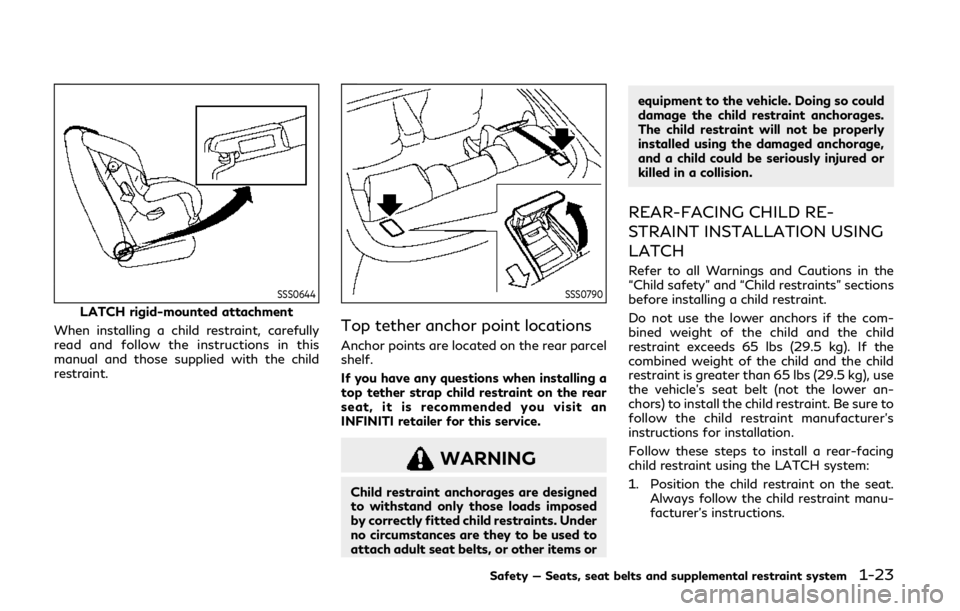
SSS0644
LATCH rigid-mounted attachment
When installing a child restraint, carefully
read and follow the instructions in this
manual and those supplied with the child
restraint.
SSS0790
Top tether anchor point locations
Anchor points are located on the rear parcel
shelf.
If you have any questions when installing a
top tether strap child restraint on the rear
seat, it is recommended you visit an
INFINITI retailer for this service.
WARNING
Child restraint anchorages are designed
to withstand only those loads imposed
by correctly fitted child restraints. Under
no circumstances are they to be used to
attach adult seat belts, or other items or equipment to the vehicle. Doing so could
damage the child restraint anchorages.
The child restraint will not be properly
installed using the damaged anchorage,
and a child could be seriously injured or
killed in a collision.
REAR-FACING CHILD RE-
STRAINT INSTALLATION USING
LATCH
Refer to all Warnings and Cautions in the
“Child safety” and “Child restraints” sections
before installing a child restraint.
Do not use the lower anchors if the com-
bined weight of the child and the child
restraint exceeds 65 lbs (29.5 kg). If the
combined weight of the child and the child
restraint is greater than 65 lbs (29.5 kg), use
the vehicle’s seat belt (not the lower an-
chors) to install the child restraint. Be sure to
follow the child restraint manufacturer’s
instructions for installation.
Follow these steps to install a rear-facing
child restraint using the LATCH system:
1. Position the child restraint on the seat.
Always follow the child restraint manu-
facturer’s instructions.
Safety — Seats, seat belts and supplemental restraint system1-23
Page 44 of 476

1-24Safety — Seats, seat belts and supplemental restraint system
SSS0648
Rear-facing web-mounted — step 2
2. Secure the child restraint anchor attach- ments to the LATCH lower anchors.
Check to make sure the LATCH attach-
ment is properly attached to the lower
anchors.
SSS0649
Rear-facing rigid-mounted — step 2
SSS0639
Rear-facing — step 3
3. For child restraints that are equipped with webbing-mounted attachments, re-
move any additional slack from the
anchor attachments. Press downward
and rearward firmly in the center of the
child restraint with your hand to com-
press the vehicle seat cushion and seat-
back while tightening the webbing of the
anchor attachments.
Page 45 of 476
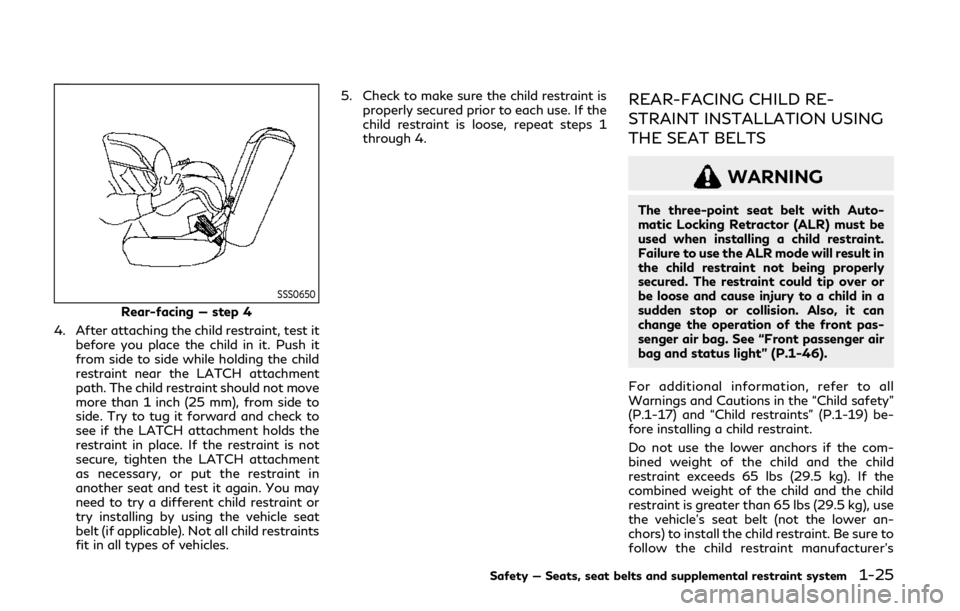
SSS0650
Rear-facing — step 4
4. After attaching the child restraint, test it before you place the child in it. Push it
from side to side while holding the child
restraint near the LATCH attachment
path. The child restraint should not move
more than 1 inch (25 mm), from side to
side. Try to tug it forward and check to
see if the LATCH attachment holds the
restraint in place. If the restraint is not
secure, tighten the LATCH attachment
as necessary, or put the restraint in
another seat and test it again. You may
need to try a different child restraint or
try installing by using the vehicle seat
belt (if applicable). Not all child restraints
fit in all types of vehicles. 5. Check to make sure the child restraint is
properly secured prior to each use. If the
child restraint is loose, repeat steps 1
through 4.
REAR-FACING CHILD RE-
STRAINT INSTALLATION USING
THE SEAT BELTS
WARNING
The three-point seat belt with Auto-
matic Locking Retractor (ALR) must be
used when installing a child restraint.
Failure to use the ALR mode will result in
the child restraint not being properly
secured. The restraint could tip over or
be loose and cause injury to a child in a
sudden stop or collision. Also, it can
change the operation of the front pas-
senger air bag. See “Front passenger air
bag and status light” (P.1-46).
For additional information, refer to all
Warnings and Cautions in the “Child safety”
(P.1-17) and “Child restraints” (P.1-19) be-
fore installing a child restraint.
Do not use the lower anchors if the com-
bined weight of the child and the child
restraint exceeds 65 lbs (29.5 kg). If the
combined weight of the child and the child
restraint is greater than 65 lbs (29.5 kg), use
the vehicle’s seat belt (not the lower an-
chors) to install the child restraint. Be sure to
follow the child restraint manufacturer’s
Safety — Seats, seat belts and supplemental restraint system1-25
Page 46 of 476

1-26Safety — Seats, seat belts and supplemental restraint system
instructions for installation.
Follow these steps to install a rear-facing
child restraint using the vehicle seat belts in
the rear seats:
SSS0100
Rear-facing — step 1
1. Child restraints for infants must be used
in the rear-facing direction and there-
fore must not be used in the front seat.
Position the child restraint on the seat.
Always follow the restraint manufac-
turer’s instructions.
SSS0654
Rear-facing — step 2
2. Route the seat belt tongue through the child restraint and insert it into the buckle
until you hear and feel the latch engage.
Be sure to follow the child restraint
manufacturer’s instructions for belt
routing.
Page 47 of 476

SSS0655
Rear-facing — step 3
3. Pull the shoulder belt until the belt is fully extended. At this time, the seat belt
retractor is in the Automatic Locking
Retractor (ALR) mode (child restraint
mode). It reverts to the Emergency
Locking Retractor (ELR) mode when
the seat belt is fully retracted.
SSS0656
Rear-facing — step 4
4. Allow the seat belt to retract. Pull up on the shoulder belt to remove any slack in
the belt.
SSS0657
Rear-facing — step 5
5. Remove any additional slack from the seat belt; press downward and rearward
firmly in the center of the child restraint
to compress the vehicle seat cushion and
seatback while pulling up on the seat
belt.
Safety — Seats, seat belts and supplemental restraint system1-27
Page 48 of 476

1-28Safety — Seats, seat belts and supplemental restraint system
SSS0658
Rear-facing — step 6
6. After attaching the child restraint, test it before you place the child in it. Push it
from side to side while holding the child
restraint near the seat belt path. The
child restraint should not move more
than 1 inch (25 mm), from side to side.
Try to tug it forward and check to see if
the belt holds the restraint in place. If the
restraint is not secure, tighten the seat
belt as necessary, or put the restraint in
another seat and test it again. You may
need to try a different child restraint. Not
all child restraints fit in all types of
vehicles.
7. Check to make sure that the child restraint is properly secured prior to each use. If the seat belt is not locked, repeat
steps 1 through 6.
After the child restraint is removed and the
seat belt fully retracted, the ALR mode (child
restraint mode) is canceled.
FORWARD-FACING CHILD RE-
STRAINT INSTALLATION USING
LATCH
Refer to all Warnings and Cautions in the
“Child safety” and “Child restraints” sections
before installing a child restraint.
Do not use the lower anchors if the com-
bined weight of the child and the child
restraint exceeds 65 lbs (29.5 kg). If the
combined weight of the child and the child
restraint is greater than 65 lbs (29.5 kg), use
the vehicle’s seat belt (not the lower an-
chors) to install the child restraint. Be sure to
follow the child restraint manufacturer’s
instructions for installation.
Follow these steps to install a forward-
facing child restraint using the LATCH
system:
1. Position the child restraint on the seat. Always follow the child restraint manu-
facturer’s instructions.
Page 49 of 476

SSS0645
Forward-facing web-mounted — step 2
2. Secure the child restraint anchor attach- ments to the LATCH lower anchors.
Check to make sure the LATCH attach-
ment is properly attached to the lower
anchors.
If the child restraint is equipped with a
top tether strap, route the top tether
strap and secure the tether strap to the
tether anchor point. See “Installing top
tether strap” (P.1-30). Do not install
child restraints that require the use of a
top tether strap in seating positions that
do not have a top tether anchor.
SSS0646
Forward-facing rigid-mounted — step 2
3. The back of the child restraint should be secured against the vehicle seatback.
If the seating position does not have an
adjustable head restraint and it is inter-
fering with the proper child restraint fit,
try another seating position or a differ-
ent child restraint.
SSS0647
Forward-facing — step 4
4. For child restraints that are equipped with webbing-mounted attachments, re-
move any additional slack from the
anchor attachments. Press downward
and rearward firmly in the center of the
child restraint with your knee to com-
press the vehicle seat cushion and seat-
back while tightening the webbing of the
anchor attachments.
5. Tighten the tether strap according to the manufacturer’s instructions to remove
any slack.
Safety — Seats, seat belts and supplemental restraint system1-29
Page 50 of 476
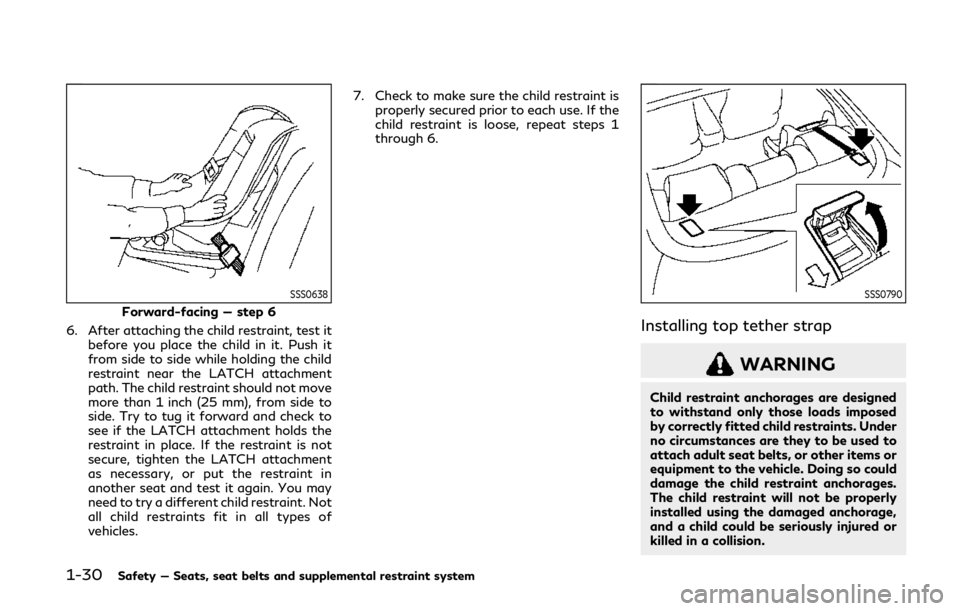
1-30Safety — Seats, seat belts and supplemental restraint system
SSS0638
Forward-facing — step 6
6. After attaching the child restraint, test it before you place the child in it. Push it
from side to side while holding the child
restraint near the LATCH attachment
path. The child restraint should not move
more than 1 inch (25 mm), from side to
side. Try to tug it forward and check to
see if the LATCH attachment holds the
restraint in place. If the restraint is not
secure, tighten the LATCH attachment
as necessary, or put the restraint in
another seat and test it again. You may
need to try a different child restraint. Not
all child restraints fit in all types of
vehicles. 7. Check to make sure the child restraint is
properly secured prior to each use. If the
child restraint is loose, repeat steps 1
through 6.
SSS0790
Installing top tether strap
WARNING
Child restraint anchorages are designed
to withstand only those loads imposed
by correctly fitted child restraints. Under
no circumstances are they to be used to
attach adult seat belts, or other items or
equipment to the vehicle. Doing so could
damage the child restraint anchorages.
The child restraint will not be properly
installed using the damaged anchorage,
and a child could be seriously injured or
killed in a collision.